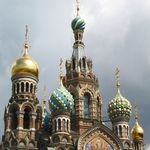Explore St.Petersburg on foot |
|
| days 1/nights 0 |
|
WALKING CITY TOUR AROUND SAINT PETERSBURG — Saint Petersburg was built on numerous islands, and is considered to be one of the most beautiful in the world. On this tour you will see all the major city highlights in the course of a 3-hour tour, including a visit to the Peter & Paul Fortress, the first building of the city and once a prison for revolutionaries and now the burial place of Russian Emperors.
ST.ISAAC'S CATHEDRAL AND THE CHURCH SAVIOR ON THE SPILLED BLOOD — St. Isaac's Cathedral was originally the city's main church and the largest cathedral in Russia. It was built between 1818 and 1858, by the French-born architect Auguste Montferrand, to be one of the most impressive landmarks of the Russian Imperial capital. The Church of the Savior on Spilled Blood — is one of the main sights of St. Petersburg, Russia. It is also variously called the Church on Spilt Blood and the Cathedral of the Resurrection of Christ, its official name. The name refers to the blood of Tsar Alexander II of Russia, who was assassinated on that site in 1881.
|

|
|
KUNSTKAMERA (The Chamber of Curiosities) — The first museum in Russia, this is one of the oldest and largest Anthropology and Ethnography museums in the world. It is also called Peter the Great's museum as it is based on the Tsar's personal collection. The museum has exhibitions of items showing the life and culture of people of various ages and from different countries.
THE RUSSIAN MUSEUM — Is the first state museum of the Russian fine art in the country. It was established in 1895 in St Petersburg under the decree of the Emperor Nicholas II. Grand opened for visitors on March 19 (March 7, the Old Style) 1898. The Russian Museum holds many exhibitions both in Russia and abroad. The Museum holds more than 50 temporary exhibitions and organizes more than 10 in other cities and abroad annually.
|

|
|
ALEXANDER NEVSKY LAVRA — A working monastery and one of the oldest architectural ensembles in Saint Petersburg — was founded in 1710 on the spot of the legendary battle with the Swedish army (by the Neva river) which determined the victory of Russia.
The construction of the monastery took nearly the whole 18th century due to frequent interruptions and was finished only by 1790. The project was a collaboration of the most talented architects of the time, but the main concept belonged to D.Tresini, who conceived the monastery complex simultaneously as a residence, a palace and an institution.
MUSEUM OF ZOOLOGY — The Museum was created in 1832 on the basis of the collection of Kuntskamera. It holds the exhibits of over 17 million species, although only 500 thousand species can be displayed in the museum's current 19th century home. Exhibits range from enormous dinosaur, mammoths and whale skeletons to stuffed animals and birds and a unique collection of butterflies. St. Petersburg Zoological Museum is considered to be one of the world's biggest museums of that kind.
|

|
|
HERMITAGE MUSEUM — The Hermitage museum displays more than 70 images of The State Hermitage that occupies six magnificent buildings situated along the embankment of the River Neva, right in the heart of St.Petersburg. Its collection consists of nearly 3 million art objects (West European art, the Antique world, Primitive culture, Oriental culture and art, the history of Russian Culture and numismatics).
The main architectural ensemble of the Hermitage situated in the centre of St Petersburg consists of the Winter Palace, the former state residence of the Russian emperors, the buildings of the Small, Old (Great) and New Hermitages, the Hermitage Theatre and the Auxiliary House.
|

|
|
|